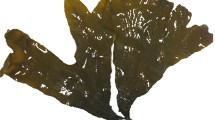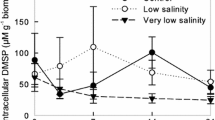Abstract
Seaweeds living at their temperature limits of distribution are naturally exposed to physiological stressors, facing additional stress when exposed to coastal pollution. The physiological responses of seaweeds to environmental conditions combining natural and anthropogenic stressors provide important information on their vulnerability. We assessed the physiological effects and ultrastructural alterations of trace metals enrichment at concentrations observed in polluted regions within the temperature ranges of distribution of the endemic seaweed Halimeda jolyana, an important component of tropical southwestern Atlantic reefs. Biomass yield and photosynthetic performance declined substantially in samples exposed to metal, although photosynthesis recovered partially at the highest temperature when metal enrichment was ceased. Metal enrichment caused substantial ultrastructural alterations to chloroplasts regardless of temperatures. The lack of photosynthetic recovery at the lower temperatures indicates a higher vulnerability of the species at its temperature limits of distribution in the southwestern Atlantic.







Similar content being viewed by others
References
Adey WH, Steneck RS (2001) Thermogeography over time creates biogeographic regions: a temperature/space/time-integrated model and an abundance-weighted test for benthic marine algae. J Phycol 37(5):677–698. https://doi.org/10.1046/j.1529-8817.2001.00176.x
Alós J, Tomas F, Terrados J, Verbruggen H, Ballesteros E (2016) Fast-spreading green beds of recently introduced Halimeda incrassata invade Mallorca island (NW Mediterranean Sea). Mar Ecol Prog Ser 558:153–158. https://doi.org/10.3354/meps11869
Andrade LR, Farina M, Amado-Filho GM (2004) Effects of copper on Enteromorpha flexuosa (Chlorophyta) in vitro. Ecotoxicol Environ Saf 58(1):117–125. https://doi.org/10.1016/S0147-6513(03)00106-4
Appenroth KJ (2010) Definition of “heavy metals” and their role in biological systems. In: Sherameti I, Varma A (eds) Soil heavy metals, soil biology, vol 19. Springer-Verlag, Berlin-Heidelberg, 448p. https://doi.org/10.1007/978-3-642-02436-8_2
Ash C, Stone R (2003) A question of dose. Science 300(5621):925. https://doi.org/10.1126/science.300.5621.925
Bandeira-Pedrosa ME, Bouzon ZL, Pereira SMB, Oliveira EC (2003) Ultrastructure of some species of Halimeda (Bryopsidales, Chlorophyta) from Brazil. Cryptogam Algol 24(3):219–231
Bandeira-Pedrosa ME, Pereira SMB, Bouzon ZL, Oliveira EC (2004) Halimeda cuneata (Bryopsidales, Chlorophyta), a new record for the Atlantic Ocean. Phycologia 43(1):50–57. https://doi.org/10.2216/i0031-8884-43-1-50.1
Barón M, Arellano JB, Gorgé JL (1995) Copper and photosystem II: a controversial relationship. Physiol Plant 94(1):174–180. https://doi.org/10.1111/j.1399-3054.1995.tb00799.x
Barraza JE, Carballeira A (1999) Chlorophyll fluorescence analysis and cadmium-copper bioaccumulation in Ulva Rigida (C. Agardh). Bol Inst Esp Oceanogr 15:395–399
Baumann H, Morrison L, Stengel DB (2009) Metal accumulation and toxicity measured by PAM—chlorophyll fluorescence in seven species of marine macroalgae. Ecotoxicol Environ Saf 72(4):1063–1075. https://doi.org/10.1016/j.ecoenv.2008.10.010
Boran M, Altinok I (2010) A review of heavy metals in water, sediment and living organisms in the Black Sea. Turk J Fish Aquat Sci 10(4):565–572. https://doi.org/10.4194/trjfas.2010.0418
Bouzon ZL, Bandeira-Pedrosa ME, Schmidt EC (2010) Ultrastructure of the siphonaceous green alga Halimeda cuneata, with emphasis on the cytoskeleton. Micron 41(6):598–603. https://doi.org/10.1016/j.micron.2010.04.001
Bouzon ZL, Ferreira EC, Dos Santos R, Scherner F, Horta P, Maraschin M, Schmidt EC (2011) Influences of cadmium on fine structure and metabolism of Hypnea Musciformis (Rhodophyta, Gigartinales) cultivated in vitro. Protoplasma 249(3):637–650. https://doi.org/10.1007/s00709-011-0301-6
Breeman AM (1988) Relative importance of temperature and other factors indetermining geographical boundaries of seaweeds: experimental and phenological evidence. Helgoländer Meeresun 42(2):199–241. https://doi.org/10.1007/BF02366043
Bréhélin C, Kessler F (2008) The Plastoglobule: a bag full of lipid biochemistry tricks. Photochem Photobiol 84(6):1388–1394. https://doi.org/10.1111/j.1751-1097.2008.00459.x
Caliceti M, Argese E, Sfriso A, Pavoni B (2002) Heavy metal contamination in the seaweeds of the Venice lagoon. Chemosphere 47(4):443–454. https://doi.org/10.1016/S0045-6535(01)00292-2
Clarke A (2003) Costs and consequences of evolutionary temperature adaptation. Trends in Ecol Evol 18:573–581. https://doi.org/10.1016/j.tree.2003.08.007
Collén J, Pinto E, Pedersén M, Colepicolo P (2003) Induction of oxidative stress in the red macroalga Gracilaria Tenuistipitata by pollutant metals. Arch Environ Contam Toxicol 45(3):337–342. https://doi.org/10.1007/s00244-003-0196-0
Costa GB, de Felix MRL, Simioni C, Ramlov F, Oliveira ER, Pereira DT, Maraschin M, Chow F, Horta PA, Lalau CM, da Costa CH, Matias WG, Bouzon ZL, Schmidt EC (2016a) Effects of copper and lead exposure on the ecophysiology of the brown seaweed Sargassum cymosum. Protoplasma 253(1):111–125. https://doi.org/10.1007/s00709-015-0795-4
Costa GB, Simioni C, Pereira DP, Ramlov F, Maraschin M, Chow F, Horta PA, Bouzon ZL, Schmidt EC (2016b) The brown seaweed Sargassum Cymosum: changes in metabolism and cellular organization after long-term exposure to cadmium. Protoplasma 254(2):817–837. https://doi.org/10.1007/s00709-016-0992-9
Costa GB, Simioni C, Ramlov F, Maraschin M, Chow F, Bouzon ZL, Schmidt EC (2017) Effects of manganese on the physiology and ultrastructure of Sargassum cymosum. Environ Exp Bot 133:24–34. https://doi.org/10.1016/j.envexpbot.2016.09.007
De Beer D, Larkum AWD (2001) Photosynthesis and calcification in the calcifying algae Halimeda discoidea studied with microsensors. Plant Cell Environ 24(11):1209–1217. https://doi.org/10.1046/j.1365-3040.2001.00772.x
Eklund BT, Kautsky L (2003) Review on toxicity testing with marine macroalgae and the need for method standardization—exemplified with copper and phenol. Mar Pollut Bull 46(2):171–181. https://doi.org/10.1016/S0025-326X(02)00225-4
Fernandes GW, Goulart FF, Ranieri BD, Coelho MS, Dales K, Boesche N, Bustamante M, Carvalho FA, Carvalho DC, Dirzo R, Fernandes S, Galetti PM Jr, VEG M, Mielke C, Ramirez JL, Neves A, Rogass C, Ribeiro SP, Scariot A, Soares-Filho B (2016) Deep into the mud: ecological and socio-economic impacts of the dam breach in Mariana, Brazil. Nat Conserv 14(2):5–45. https://doi.org/10.1016/j.ncon.2016.10.003
Fodor F, Böddi B, Sárvári É, Záray G, Cseh E, Láng F (1995) Correlation of iron content, spectral forms of chlorophyll and chlorophyll-proteins in iron deficient cucumber (Cucumis sativus). Physiol Plant 93(4):750–756. https://doi.org/10.1111/j.1399-3054.1995.tb05127.x
Garcia LC, Ribeiro DC, Roque FO, Ochoa-Quintero JM, Laurance WF (2017) Brazil’s worst mining disaster: corporations must be compelled to pay the actual environmental costs. Ecol Appl 27(1):5–9. https://doi.org/10.1002/eap.1461
Gomes LEO, Correa LB, Sá F, Neto RR, Bernardino AF (2017) The impacts of the Samarco mine tailing spill on the Rio Doce estuary, Eastern Brazil. Mar Pollut Bull 120(1–2):28–36. https://doi.org/10.1016/j.marpolbul.2017.04.056
Guimaraens MA, Coutinho R (2000) Temporal and spatial variation of Ulva spp. and water properties in the Cabo Frio upwelling region of Brazil. Aquat Bot 66(2):101–114. https://doi.org/10.1016/S0304-3770(99)00070-4
Haiyan W, Stuanes AO (2003) Heavy metal pollution in air-water-soil-plant system of Zhuzhou City, Hunan Province, China. Water Air Soil Pollut 147(1/4):79–107. https://doi.org/10.1023/A:1024522111341
Hajimad T, Vedamanikam VJ (2013) Temperature effects on the toxicity of four trace metals to adult spotted Babylonia snails (Babylonia areolata). Toxicol Environ Chem 95(8):1380–1387
Hallock P, Schlager W (1986) Nutrient excess and the demise of coral reefs and carbonate platforms. PALAIOS 1(4):389–398. https://doi.org/10.2307/3514476
Han T, Sung-Ho K, Ji-Sook P, Han-Kyun L, Murray TB (2008) Physiological responses of Ulva Pertusa and U. Armoricana to copper exposure. Aquat Toxicol 86(2):176–184. https://doi.org/10.1016/j.aquatox.2007.10.016
Heumann HG (1987) Effects of heavy 442 metals on growth and ultrastructure of Chara vulgaris. Protoplasma 136(1):37–48. https://doi.org/10.1007/BF01276316
Hillis-Colinvaux L (1980) Ecology and taxonomy of Halimeda: primary producer of coral reefs. Adv Mar Biol 17:1–327. https://doi.org/10.1016/S0065-2881(08)60303-X
Hoffman R, Dubinsky Z, Israel A, Iluz D (2008) The mysterious disappearance of Halimeda tuna from the intertidal zone along the Israeli Mediterranean. Israel J Ecol Evol 54:267–268
Martins CDL, Arantes N, Faveri C, Batista MB, Oliveira EC, Pagliosa PR, Fonseca AL, Nunes JMC, Chow F, Pereira SB, Horta PA (2012) The impact of coastal urbanization on the structure of phytobenthic communities in southern Brazil. Mar Pollut Bull 64(4):772–778
Martone PT (2010) Quantifying growth and calcium carbonate deposition of Calliarthron cheilosporioides (Corallinales, Rhodophyta) in the field using a persistent vital stain. J Phycol 46(1):13–17. https://doi.org/10.1111/j.1529-8817.2009.00770.x
Mather L, MacIntosh K, Kaczmarska I, Klein G, Martin JL (2010) A checklist of diatom species reported (and presumed native) from Canadian coastal waters. Can Tech Rep Fish Aquat Sci 2881:84
Mazzei EF, Bertoncini AA, Pinheiro HT, Machado LF, Vilar CC, Guabiroba HC, Costa TJF, Bueno LS, Santos LN, Francini-Filho RB, Hostim-Silva M, Joyeux JC (2017) Newly discovered reefs in the southern Abrolhos Bank, Brazil: anthropogenic impacts and urgent conservation needs. Mar Pollut Bull 114(1):123–133. https://doi.org/10.1016/j.marpolbul.2016.08.059
Meng W, Qin Y, Zheng B, Zhang L (2008) Heavy metal pollution in Tianjin Bohai Bay, China. J Environ Sci (China) 20(7):814–819. https://doi.org/10.1016/S1001-0742(08)62131-2
Morillo J, Usero J, Gracia I (2004) Heavy metal distribution in marine sediments from the Southwest Coast of Spain. Chemosphere 55(3):431–442. https://doi.org/10.1016/j.chemosphere.2003.10.047
Ouzounidou G, Elefteriou EP, Karataglis S (1992) Ecophysiological and ultrastructural effects of copper in Thlapsi ochroleucum (Cruciferae). Can J Bot 70(5):947–957. https://doi.org/10.1139/b92-119
Pätsikkä E, Kairavuo M, Frantisek S, Aro E, Tyystjärvi E (2002) Excess copper predisposes photosystem II to photoinhibition in vivo by outcompeting iron and causing decrease in leaf chlorophyll. Plant Physiol 129(3):1359–1367. https://doi.org/10.1104/pp.004788
Ritchie RJ (2006) Consistent sets of spectrophotometric chlorophyll equations for acetone, methanol and ethanol solvents. Photosynth Res 89(1):27–41. https://doi.org/10.1007/s11120-006-9065-9
Santos RW, Schmidt EC, Bouzon ZL (2013) Changes in ultrastructure and cytochemistry of the agarophyte Gracilaria domingensis (Rhodophyta, Gracilariales) treated with cadmium. Protoplasma 250(1):297–305. https://doi.org/10.1007/s00709-012-0412-8
Scherner F, Bonomi JB, Horta PA (2012) Photosynthetic response of two seaweed species along an urban pollution gradient: evidence of selection of pollution-tolerant species. Mar Pollut Bull 64(11):2380–2390. https://doi.org/10.1016/j.marpolbul.2012.08.012
Scherner F, Ventura R, Barufi JB, Horta PA (2013) Salinity critical threshold values for photosynthesis of two cosmopolitan seaweed species: providing baselines for potential shifts on seaweed assemblages. Mar Environ Res 91:14–25. https://doi.org/10.1016/j.marenvres.2012.05.007
Segura FR, Nunes EA, Paniz FP, Paulelli ACC, Rodrigues GB, Braga GUL, Filho WR et al (2016) Potential risks of the residue from Samarco’s mine dam burst (Bento Rodrigues, Brazil). Environ Pollut 218:813–825. https://doi.org/10.1016/j.envpol.2016.08.005
Sissini MN, Longo GO, Martins CDL, Floeter SR, Pereira SB, Horta PA (2014) First record of the green alga Halimeda (Bryopsidales: Chlorophyta) at Rocas Atoll—natural dispersion or anthropogenic causes? Mar Biodivers Rec 7:1–5. https://doi.org/10.1017/S1755267214001018
Somero GH (2002) Thermal physiology and vertical zonation of intertidal animals: optima, limits, and costs of living. Integr Comp Biol 42(4):780–789. https://doi.org/10.1093/icb/42.4.780
Torres MA, Barros MP, Campos SCG, Pinto E, Rajamani S, Sayre RT, Colepicolo P (2008) Biochemical biomarkers in algae and marine pollution: a review. Ecotoxicol Environ Saf 71(1):1–15. https://doi.org/10.1016/j.ecoenv.2008.05.009
Verbruggen H, De Clerck O, N’yeurt ADR, Spalding H, Vroom PS (2006) Phylogeny and taxonomy of Halimeda incrassata, including descriptions of H. kanaloana and H. heteromorpha spp. nov. (Bryopsidales, Chlorophyta). Eur J Phycol 41(3):337–362. https://doi.org/10.1080/09670260600709315
Wang M, Wang W (2008) Temperature-dependent sensitivity of a marine diatom to cadmium stress explained by subcelluar distribution and thiol synthesis. Environ Sci Technol 42(22):8603–8608. https://doi.org/10.1021/es801470w
Wang J, Liu RH, Yu P, Tang AK, Xu LQ, Wang JY (2012) Study on the pollution characteristics of heavy metals in seawater of Jinzhou Bay. Procedia Environ Sci 13:1507–1516. https://doi.org/10.1016/j.proenv.2012.01.143
Wilson S, Blake C, Berges JA, Maggs CA (2004) Environmental tolerances of free-living coralline algae (Maerl): implications for European marine conservation. Biol Conserv 120(2):279–289. https://doi.org/10.1016/j.biocon.2004.03.001
Xia JR, Li YJ, Lu J, Chen B (2004) Effects of copper and cadmium on growth, photosynthesis, and pigment content in Gracilaria lemaneiformis. Bull Environ Contam Toxicol 73(6):979–986. https://doi.org/10.1007/s00128-004-0522-x
Funding
This work was supported by grants from Capes (Higher Education Personnel Improvement Coordination), CNPq (National Council for Scientific and Technological Development), REDEALGAS (Brazilian Research Network on Global Climate Change), Rede de Pesquisa Coral Vivo, FINEP/Rede CLIMA, Boticario Foundation and FAPESC (Foundation support research and innovation in the State of Santa Catarina). Barufi, J.B. assisted with chlorophyll a extractions. Wegher, D. provided laboratorial assistance during experimental procedures. Yokoya, N. and Santos, R. critically reviewed a previous version of this manuscript.
Author information
Authors and Affiliations
Corresponding author
Additional information
Responsible editor: Yi-ping Chen
Rights and permissions
About this article
Cite this article
Scherner, F., Bastos, E., Rover, T. et al. Halimeda jolyana (Bryopsidales, Chlorophyta) presents higher vulnerability to metal pollution at its lower temperature limits of distribution. Environ Sci Pollut Res 25, 11775–11786 (2018). https://doi.org/10.1007/s11356-018-1395-6
Received:
Accepted:
Published:
Issue Date:
DOI: https://doi.org/10.1007/s11356-018-1395-6




